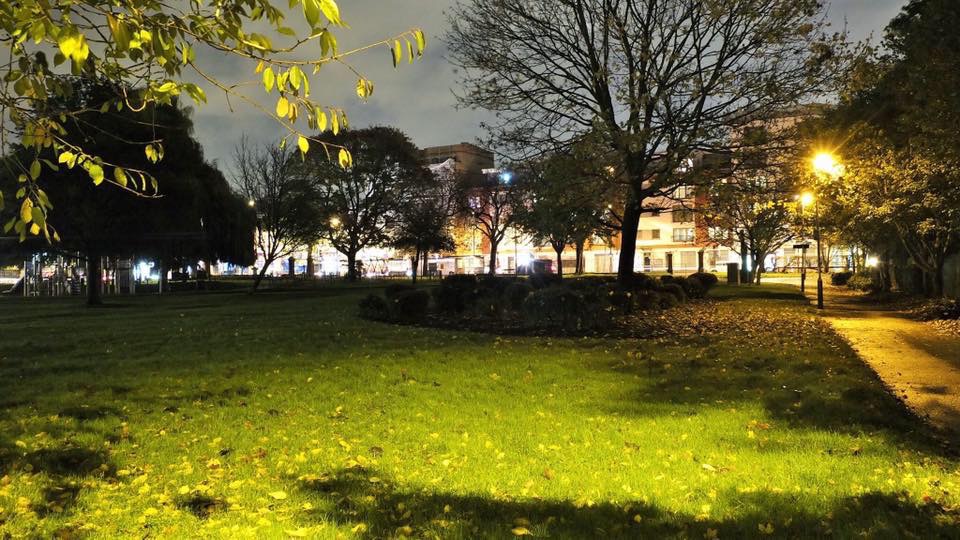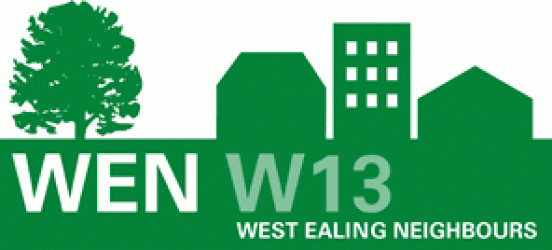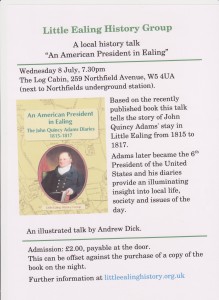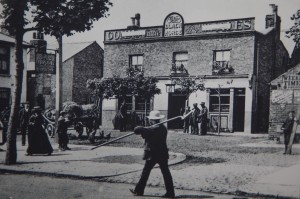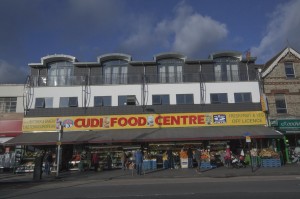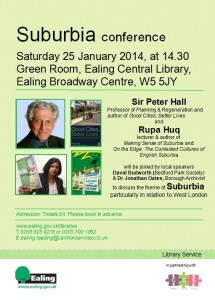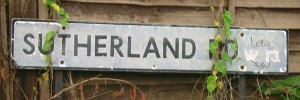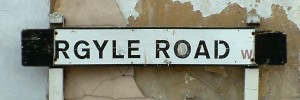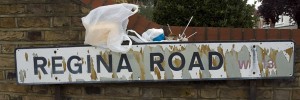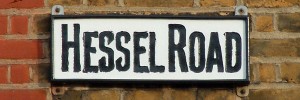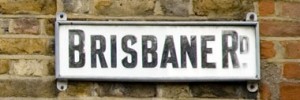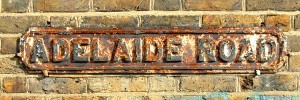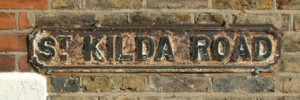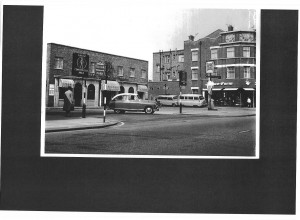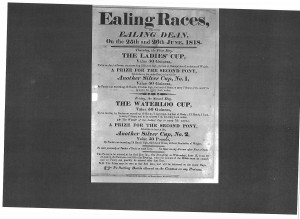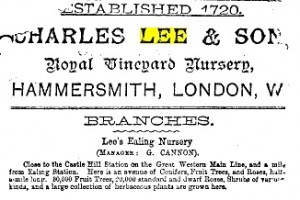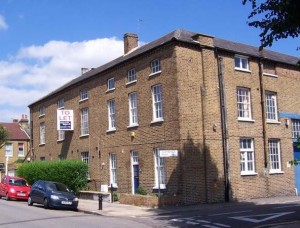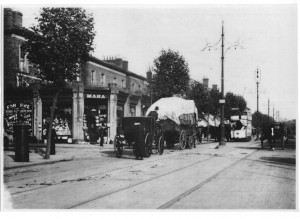I’ve read the recently published book which tells the story of John Quincy Adams’ stay in Ealing as US representative to Great Britain before he became the 6th President of the United States. For two years, 1815-1817 he lived at Little Boston House just across from Boston House. The book is based on his detailed diaries and gives a facsinating insight in to life and society in Ealing. He was a great walker and he visited the Ealing Races at Ealing Dean (including what is now Dean Gardens) which was well known for pony and donkey racing – leading to its nickname of ‘Jackass Common’. This talk on Wednesday 8th July at The Log Cabin near Northfields station should be worth the £2 admission fee.
See what West Ealing looked like 100 years ago and stock up with WEN Abundance produce at The Grosvenor on Saturday 4th October
The newly refurbished pub The Grosvenor has started to host pop-up stalls on Saturdays and WEN is there this coming Saturday 4th October from 12noon – 4pm. We’ll have our Abundance produce on sale and another chance to see our newly-launched exhibition of old photos of West Ealing.
Changing times: Once The Black Horse pub and now the Cudi Food Centre
We launched our local history exhibition at the SoundBite Festival on 13th September and had a lot of interest. This exhibition of photos of West Ealing over the past 100 years is the start of our local history project. You can see how pubs, shops, Northfields, the Draytons and more looked in the early 1900s and now 100 years later.
Our Abundance stall will have apple juice, elderflower cordial, chutneys and more on sale – all made from locally grown produce.
If nothing else, just drop by for a drink and a chat as there’ll be a number of WEN members there.
Find out more about Hanwell’s history – Saturday 4th October at Hanwell Library
Come along to Hanwell heritage and local history drop-in meetings on the first Saturday of each month. Next meeting is Saturday 4th october 11am-1pm and 2-4pm at Hanwell Library in Cherington Road.
Researching local and family history talk Saturday 10th May
Local History Workshop at Ealing Central Library on Saturday 10th May 2.30pm. Cost £4
Speaking from personal experience , there’s always a surprise waiting when you start researching your family history. In my case it was my paternal great-great grandfather and how many children he had by whom and when – and I still haven’t got to the bottom of it. Let alone why on earth he appears to have sent his very elderly parents from Liverpool to a large house on the Isle of Man in the mid 1800s – a complete mystery!
Whether it’s local history or family history you might be interested in the Local History Workshop run by historians Dr Jonathan Oates and Dr Piotr Stolarski on Saturday 10th May in the Green Room at Ealing Central Library at 2.30pm. The cost is £4. Places are limited so you can book by calling 020 3700 1052 or email reading@ealing.gov.uk
There are other talks as well:
Shops of Yesteryear by Prof Alan Gillett on 8th May at 6.15pm
The Private Asylums of Ealing by Paul Lang on 26th June at 6.15pm
Suburbia and west London conference on Saturday 2.30pm
A summit meeting cum conference on the subject of suburbia with particular reference to west London will take place this Saturday 25th January at Ealing Central Library from 2.30. A series of talks will be delivered by speakers including Ealing borough historian Jonathan Oates, the Sociology Lecturer and former Deputy Mayoress of Ealing Dr Rupa Huq and the eminent academic and previous government advisor on urbanism and planning Sir Professor Peter Hall. Professor Hall, author of some 40 books will be discussing his latest “Good Cities, Better Lives” and Dr Huq will draw on her recent two titles “On the Edge” and “Making Sense of Suburbia Through Popular Culture”. Other topics to be probed include the status of Bedford Park as the world’s first garden suburb, Britpop and why riots came to Ealing in 2011. All are welcome.
Origins of some West Ealing street names – part three
A bit of light reading for the summer holidays – the last of three articles by local historian David Shailes on the origins of some West Ealing street names:
‘The Wood family owned a large estate in Ealing and the family’s ancestral home was Culmington Manor, Craven Arms, Shropshire, hence Culmington Road. The family are more associated with roads in other parts of Ealing W3/W5: Aston, Boileau, Corfton, Craven, Hamilton, Madeley, Woodville, Woodfield, Woodgrange all take their names from places or people associated with this family. Broughton Road in W13 also fits in to the above group.
Elers Road in Northfields takes it name from the Elers Family that owned some land here in Victorian times, but did not live in Ealing. They gave land to the local board so that an entrance on to Northfield Avenue to Lammas Park could be built. Nearby Carew Road is also linked with the family.
Robinson Close is built on the site of the old Robinson Nursery which survived until the 60’s as the writer remembers the development of the site.
Not too far away are Amherst Road & Gardens, which are named after Charles Thomas Amherst (1832 – 1909), a jeweller and owner of Castlebar House from 1871.
The only link that at the moment I have found for Argyle Road relates to John Campbell Duke of Argyll who owned Ealing Grove from 1775 until 1791: a house near Grove Road in Ealing Broadway described as a mansion house with 64 acres of land. An alternative explanation is that the developer used a Scottish theme as nearby is Sutherland Road.
Close by is Egerton Gardens for which there are two possible explanations: the 1st Earl of Ellesmere in Shropshire – Francis Egerton (1800 to 1857) or the Bishop of Durham a Dr John Egerton (1721 to 1787) who owned Elm Grove a house near Ealing Common. This latter house was owned by Spencer Perceval (1762 to 1812) who is the only British Prime minister to be assassinated. Ealing Council offices in the Uxbridge Road are named after him.
Montague Road is likely to be named after Sir Montagu Sharpe – 1856 to 1942. Whilst he lived at Hanwell Park in Hanwell he had a greater involvement with Brentford than Ealing. He was a significant individual involved with the Middlesex County Council, which before the London Borough’s were created in 1964, was the County Council responsible for Ealing.
Since starting writing these articles a very chance discovery following a conversation with a relative who happened to mention that she had recently read a book about a Lord Ellesmere saw a cursory internet search reveal a possible explanation for the naming of the road I live in – Erlesmere Gardens. There are a few other Erlesmere street names throughout the UK, but no place name with such a spelling. Nearby are Walmer & Balmoral gardens, which were built at the same time, by the same developer and could be named after castles.
It now looks like it is from a fictional story called “Erlesmere: or, Contrasts of Character” by LS Lavenu first published in 1856. Erlesmere is a village that features in the book.
The two previous articles are:
plus
Victorian West Ealing’s market gardens and nurseries
David Shailes
Origins of some West Ealing street names – part 2
It should come as no surprise that many of our names have royal connections, partly for patriotic reasons but also reflective of the fact that Duke of of Kent (1767 -1820) Edward Augustus, father of Queen Victoria lived at Castle Hill Lodge from 1801-12. A replacement house was built in 1845 and a small part still exists and is now occupied by St David’s Home. So we have Kent Gardens, Regina Road/Terrace and Victoria Road/ Cumberland Road in W5/W7.
An interesting name of agricultural origins is Hessel Road and a member of Steel family told me that the family use to grow the Hessel Pears, hence this name. “Excellently hardy pear. Ready October. Round to conical fruit. Pale yellow with small russeted dots. Quite a sweet fruit. Does well in the north of country. Crops very heavy. Found in Hessle, Yorkshire.” An internet search reveal you can buy a tree for £12.75. Other fruit names which are just in W5 in Little Ealing are named after varieties of cooking apples Bramley, Julian & Wellington roads, which were built on land developed by the Steel family.
While on the agricultural theme, the names of fields often find themselves being used for street names. The obvious ones Broomfield Road/Place, Churchfield, Courtfield, Glenfield Road/Terrace, Kirkfield, Mayfield, Middlefielde, Northfields, Westfield. A very un-obvious one is Northcroft Road, which probably takes it name from a field called North Kings Croft. The road itself follows a footpath that linked Windmill road in Little Ealing with West Ealing.
Northfield’s school site is bordered on one side by Balfour Road and nearby are Salisbury and Chamberlain Roads, all of these undoubtedly take their name from politicians of the period. Balfour was Prime Minister in 1902 when the Education Act of that year, made education compulsory. The previous 1870 act had allowed local communities if they so decided to offer education and to recoup the cost through the “rates” (now Council Tax), consequently the provision was patchy. The passing of act prompted much school building and Northfield school dated from this period. The building design was used for Little Ealing School as well, which saved on the cost. Balfour had previously served in his Uncle’s – Lord Salisbury cabinet, which is where we get Salisbury Road from. Chamberlain Road is named after Joseph Chamberlain (1836 – 1914) who in his early years was a campaigner for educational reform, serving as Mayor of Birmingham before becoming an MP, rather than his more famous son Neville Chamberlain. It was Neville who signed the Munich Agreement in 1938, which was popular with most people in Britain because it appeared to have prevented a war with Nazi Germany. Charles Steel was a a conservative party supporter and was probably behind the naming of these roads.
Whilst in this area Marder road takes its name from the Marder Estates, which was land purchased by the Steel family and for a while they were early estate agents with an office at 2 Plough Terrace called (The South Marder Estates Co ). Ironically, the building is still used today as an estate agents.
David Shailes (to be continued).
Origins of some West Ealing street names – part 1
A couple of weeks ago I said I’d post some of our local history pieces from past newsletters. Here is the first of three articles by David Shailes on the origins of some of our local street names:
Origins of some local street names – part 1
When the streets of Ealing were originally laid out the landowners and property developer got to choose the names, so the reasons for their choices are generally not recorded and are lost in the mist of time. Researching street names is interesting for lots of reasons as some have names of local historical interest, others have no local connections and some are linked to events in history.
The length of this article means that we can only scratch the surface of the 200 odd roads that have a W13 post code.
A set of my personal favourites are the Australian named roads: Adelaide Road, Brisbane Road, Sydney Road and Melbourne Avenue and these were all on land developed by the Steel family and it is known that Charles Steel whose market garden at one stage made him the largest rate payer in Ealing, went to Australia to see how they did things down under. So this may be the reason they have such names.
Loveday Road takes it name from William Lockyer Loveday, who owned land in Ealing, but lived in Devon, which he left in 1860 to start a new life in the State of Illinos in the USA. His son eventually became the owner of what was called the Loveday Estates and these were sold in 1896 for £60,000, a considerable sum of money. The St Kilda and Marder Estates, have also given their names to two roads.
Horticulture gave us Leeland Road andTerrace, as these stand on part of the land that once was part of Charles Lee & son’s Ealing nursery, they had other nurseries in Hammersmith (The Olympia Exhibition hall stands on the site), Feltham, Isleworth and Hounslow. They used the site to grow fruit trees, roses and shrubs.
As a child I lived in Green Avenue and never gave the street name a second thought as there are no other streets named after colours nearby. It appears that the name relates to a H.C. Green who was the very first mayor of the Borough of Ealing in 1901/2. Next to this road is Cranmer Avenue that runs up to St Paul’s Church and on the opposite side is Ridley Avenue, which take their names from two Protestant Martyrs burnt at the stake by Mary Tudor (Queen 1553 to 1558).
The 1777 parish map reveals that North Field Lane (now Northfield Avenue) and Mattock Lane have been with us for over 200 years. My mother who lived in Ealing right up until her death in 1983 always referred to going shopping as up the “lane” meaning Northfield Avenue. Drayton Green existed as a small community on this map, which gave its names to several nearby roads.
Green Man Lane took its name from a old coaching inn on the Uxbridge Road, the second world war damaged pub being rebuilt in the 1950’s (photo above) was demolished in 1981 and replaced by the block which Iceland is now in. The inn existed on the 1777 map and was an important stabling facility for over 100 horses on the London to Oxford road and on further west to Fishguard (No A40 in those days!).
(to be continued)
David Shailes
Victorian West Ealing’s market gardens and nurseries – a short history
Over the years we’ve published a wide range of articles on local history in our newsletters. I keep saying to myself that I must collect them together on our website and make them easily accessible as they are a bit hard to find. In the meantime, I thought I’d publish some of them on our blog as not everyone will have had the chance to read them. This one gives a glimpse in to West Ealing’s history as a market garden for the ever-growing population of London.
In Victorian times much of the land of West Ealing south of the Uxbridge Road was used for agriculture and, in particular, market gardens, nurseries and orchards. Local historian David Shailes has researched the history of West Ealing in considerable detail and this short extract from his work gives a fascinating insight into an important part of our local history and has helped inspire West Ealing Neighbours’ Abundance project.
On the 6th February 1832 the Bishop of London transferred what was then known as ‘Jackass Common’ to the Parish for use as allotments. At the north end of Northfield Avenue there remains one set of allotments. Similar allotments existed on the other side until the early 1980’s when the western allotment site was compulsorily purchased and developed for housing with the Sherwood Close Estate along with sheltered accommodation belonging to what is now the Pathways charity – the owner of the two allotment sites. These two allotments together with Dean Gardens(created in 1911) formed part of ‘Jackass Common’ which was described at the time as being covered in rough furze. The Jackass referred to the annual donkey races held until they were deemed too unruly (what we would now call anti-social behaviour!).
Poster for the annual ‘Jackass Races’ from the early 1800s
The next field along the Uxbridge Road stretched from what is now Dean Gardens to Coldershaw Road and in the 1839/40 Tithe survey was owned by the Loveday Estates and known as ‘Green Man Field’ being used as arable land by Elizabeth Humphreys. Directly beneath this was a field which stretched down to what is now Leighton Road, from appoximately Leeland Terrace in the north to Coldershaw Road in the west. This was farmed by John Meacock of Little Ealing.
Entry from a Victorian trade directory
The first nursery on part of the site which stretched all the way to what is now Leighton Road in the south, was bordered by the allotments in the east, the Uxbridge Road in the north to what is Westfield Road in the west was run by Charles Lee & Sons. This is first mentioned in an advertisement the Kelly’s Directory of 1895/6:
‘Close to Castle Hill Station(West Ealing) on the Great Western Main Line and a mile to Ealing Station there is an avenue of conifers, fruit trees and roses half a mile long – 30,000 fruit trees, 20,000 Standard & dwarf roses. Shrubs of various kinds and also a collection of herbaceous plants.’
They left the site in about 1902 when the Loveday Estates sold their land for housing development. They moved for a few years to a site on the Uxbridge Road at Ealing Common, before disappearing. But they left us with the street names Leeland Road/Terrace.
From what is now Melbourne Avenue to St James Avenue was occupied by Charles Steel & Sons. The Steel family had a market garden business in Ealing from about 1837, but the first entry in a trade directory is in Mason’s (1853) on land at Boston Gardens, Boston Road. This was tucked behind Boston Farm and was on part of the land which forms the allotments to west end of Northfields Recreation Grounds. They were still here in the 1860 directory. Charles Steel Jnr is shown as having a market garden in Gunnersbury in the 1877 directory and by 1878 has a further garden at Castle Bar Hill.
The Steel Fruit Warehouse
By 1886 the first street of houses has appeared in Northfields and this was Northfield Road and at the western end Charles Steel & Sons had premises on the northside. These premises are still extant and have always looked out of place with the rest of the area, as they are a three-storey warehouse type building which incorporates Ivy Cottage.
In the 1891 census this was occupied by G.A.Simmonds – Agricultural Foreman and an additional location known as Steel’s Farm was occupied by H.Hallet – Gardeners Foreman. Quite a few of the inhabitants of Northfield Road were connected with gardening or were described as agricultural labourers.
Lido Junction circa 1905
By 1894/5 Charles Steel is living at 228 Uxbridge Road, which was virtually opposite the northern end of his market garden. In his obituary in the Middlesex County Times in July 1911 it states that he had a market garden which stretched from the Uxbridge Road in the north to the District Railway in the south. This is more or less confirmed by the Ealing General Rate book in the GLO dated 4/4/1889. He died on 19th July 1911 at the age of 74 and had lived all his life (bar the first 3mths) in Ealing – initially at Boston Gardens.
In the pursuit of his profession he had visited Australia, which in the days of no aviation was no mean feat. He served for the first year of the new Borough as a Councillor (1902) and stood down, as in those days the Council was not re-elected en-masse every 4 years, but a proportion of ward councillors stood for re-election each year. He did not stand for re-election.
Adelaide Road is one of the ‘Australian- named’ roads on land developed by the Steel family
The ordnance survey map for 1894/5 clearly shows trees to the west of Steel’s warehouse, which I have presumed were orchards as Charles Steel’s business is described as a Fruit Grower. As his market garden shrank in size he retained these premises and appeared to have moved out by 1912 the year after his death.
He had let space to Albert Harris a Horticultural builder from 1907. Initially after Steel’s death only Harris is shown as the occupant. In 1926 the occupants are Sanders who are using them as a Furniture Depository.
When Charles Steel died his Estate was worth £59,706 17s 6d (Somerset House). Charles had a brother Richard J. who was an Auctioneer and Land Agent who initially had an office in Hanwell (Kelly’s Directory 1887/8)and is also shown as a Market Gardener at Boston Gardens. By 1894/5 he had given up his Hanwell offices to establish his Auctioneering business at Southall market. He was still living at Boston Gardens when he died on 12/8/1916. His Estate on his death was worth £26,115 5s 1d (Somerset House).
(Our newletters have three articles about the origins of local street names. This link is to the first of these articles. The July and September newsletters have the two subsequent articles on street names.)
This week’s gigs at Ealing’s historic blues club
I have a bit of a personal interest in this post. My taste in music was heavily influenced by my brother who is five years older than me. He was a teenager living in London from mid-1964 onwards and he was an avid fan of blues music so was always going to the Marquee Club , Eel Pie Island and many other clubs and venues, though not The Ealing Club as he told me its heyday was over by 1964. So, Ealing’s central role in the development of British blues music in the early 1960s was indirectly crucial to my musical education. Alistair who is raising funds for a blue plaque to mark the role of The Ealing Club has dropped in to OPEN a couple of times to promote his special fund-raising blues nights at the club and I hope he succeeds with his efforts to get greater recognition of the role played by Alexis Korner and The Ealing Club. I couldn’t get to any of the previous blues nights in the summer so I hope this time I can manage to get along to one of the nights. Details of the three nights are below.
(You can listen to a BBC Radio 6 programme about Alexis Korner and his contribution to British music which talks about The Ealing Club at http://www.bbc.co.uk/iplayer/episode/b008tt3x/Alexis_Korner_Rhythm_and_Blues_Champion_Juvenile_Delinquent/ )
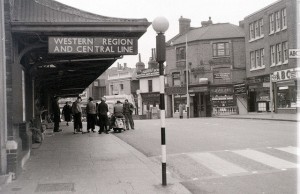 The Ealing Club Blue Plaque Gigs
The Ealing Club Blue Plaque Gigs
To raise the final funds for the Ealing Club plaque, we have managed to put together three nights of music, featuring many musicians who realise the importance of the venue and are offering their time and input to help celebrate it.
The club, now called The Red Room, is diagonally opposite the station by the set of stairs that goes down to the footpath that brings you out on the Uxbridge Road almost opposite the entrance to the Ealing Broadway Shopping Centre.
(The photo shows Ealing Broadway station in the 1960s looking across to The Ealing Club.)
22nd November:
The Hubcaps –
Blues Covers and Original Material, with a very accomplished Harmonica Player at the helm.
The Bolaji Blues Band –
Searing Blues Guitar will be on offer from this local band, who are rapidly sealing a reputation for their interpretation, of well known blues classics.
Brace Yourself –
Following their brushes with Banksy in their former guise as Exit through the Gift Shop, this band entertained and went down a storm at their last Ealing Club Fringe performance. Guitar covers of 70′s/80′s 90′s classics.
23rd November:
Live music on Wednesday, will have a tinge of Jazz with the band Fallen Heroes, who ave already graced the Liverpool Jazz Festival and Ronnie Scotts. Cyril Davies may not have approved of the brass section but maybe Alexis would have given it a go.
The night will be hosted by Swamprock Dj’s Carol Lateman and Nigel Bewley. Sure to be lively, upbeat and of the highest quality. http://thefallenheroes.com/
24th November:
The Blues Tribute night on Thursday will serve up the Blues ……Robert Hokum/Guvnors, Norrie Burnett (British Blues pioneer who even played with Cyril Davies) Doc Stenson (Singer, Guitar and Harmonica player, who played with Alexis Korner and entertained audiences at the July Ealing Fringe Gigs) with Ramon Goose and Geoff Garbow
Please e-mail us to reserve a place on the door, as we will limit the audience to 100 per night – ealing-club@hotmail.co.uk
More details available on the websites:
David Highton
